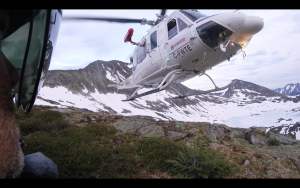BC Air Rescue News
BC Air Rescue: A life saving venture for the interior of BC
On Tuesday February 24th 2015, I got the privilege to be invited for a helicopter rescue exercise by a new Kelowna based Venture, BC Air Rescue. When Vice President Ian Wilson told me that he wanted me to shoot the exercise from inside the heli, I instantly jumped off my office seat out of excitement. A quick trip home to grab the camera gear and onward we went. At the Wildcat Helicopter base in West Kelowna, home of BC Air Rescue, we meet representatives from various ski resorts from the interior of BC, all eager to witness the specially equipped Bell 412 and its crew perform.
BC Air Rescue has teamed up with career Rescue Specialists, to have the very best paramedics onboard. Their Bell 412 is equipped with a special winch system that can lower paramedics up to 250 feet in just a minute. It also has the very latest medical and paramedical equipment onboard, in order to provide medical assistance to the patient(s) in flight to the hospital. This chopper is the first non-military aircraft in the country with such hoist and medical capabilities.
After a security briefing by Chief Pilot Dave Hauber, we all get onboard. Cameras are rolling, as the blades rapidly get in motion. Soon after the motor reaches its optimal rpm, we take off. We then fly towards the local snow dusted hills, witnesses of an unusually warm and dry winter in the Okanagan. The Bell 412 is a workhorse and its lifting power tangible: Not only can it fly with 9 seated passengers; it can also serve as an air ambulance for two medical patients simultaneously. With a range of 720 kilometres and a top speed of 240 km/h, the B.C. Rescue helicopter can be in the air for about three hours at a time. Such characteristics make the Bell 412 a perfect candidate for the safety duty. Its rapid response capability means it can reach throughout the Southern Interior region in a matter of minutes.

The interior of BC has stunning nature to offer. Great for hikers, not for road rescue | Photo: Steve Rosset
After dropping everyone on the ground, the heli takes off again. Onboard are a Paramedic Rescue Technician, Rescue Winch Operator, Dave, and myself. We hover above the rescue location, open the door, and get properly anchored. Shortly after Dave stabilizes the 412, the Paramedic Rescue Technician is getting lowered to the ground with the winch. Seconds later, he is mobilizing the patient on the ground and preparing to be airlifted. My clock is ticking, seconds pass. Dave is master pilot, keeping the heli perfectly still, even with strong turbulent wind. The winch is activated, and soon enough two heads poke at my height. The Rescue Winch Operator hoists the patient in, while the Paramedic secures best online casino himself back to the heli. Two minutes later, we land back at the West Kelowna base. This was just an exercise. In real time, the 412 would have taken the patient straight to the Hospital.
After a rapid debriefing, and I hear that the Rescue and Medical Crew who have teamed up with BC Air Rescue have decades of international winch rescue experience, better explaining the flawless execution throughout the exercise. “Regular practices help us maintain our A+ game, we train as often as possible” explains the Paramedic Rescue Technician. While I do not wish anyone to ever be in a situation where a helicopter rescue is needed, it is reassuring to see how seriously BC Air Rescue members take their duty. “It’s all about saving lives and increasing life quality” selflessly explains Ian. “Since the recent launch of our venture, we have been called 11 times. We always were first on site and operated rapidly. In the majority of those calls, a traditional ground rescue would have taken hours”.



